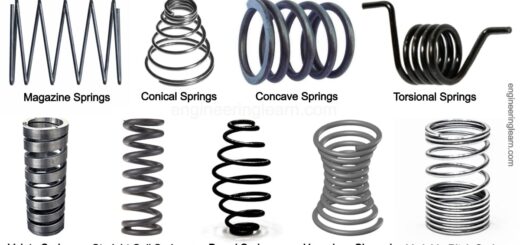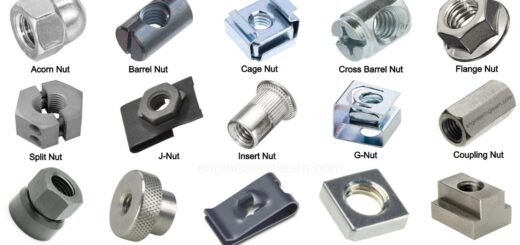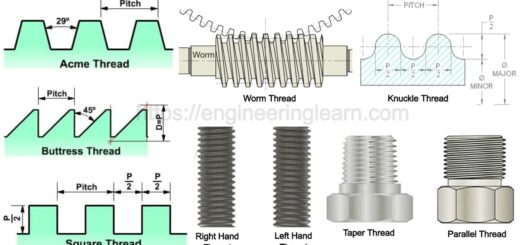Types of Stud Fastener: Threaded Stud Bolt, Undercut Studs & Wall Studs [with Pictures]
![Types of Stud Fastener: Threaded Stud Bolt, Undercut Studs & Wall Studs [with Pictures]](https://engineeringlearn.com/wp-content/uploads/2021/06/Stud-1024x539.jpg)
What is Stud Fastener?
Types of Stud Fastener: Threaded Stud Bolt, Undercut Studs, Wall Studs :- Studs along with the thread or proprietary-lock thread are used to provide a positive lock against turning and loosening. The lock helps in assembling and disassembling the locknuts on studs and is mostly important where there is a requirement of maintaining a pre-stress to combat fatigue failures. Studs which is applied with the sealant helps in preventing the leakage of fluids via holes which are tapped in porous materials.
A stud is referred to as a vertical framing member which is found forming parts of a wall or a partition. These are also referred to as wall studs as they are a fundamental component of frame construction and are most commonly made of timber. However, talking about the steel studs, they are found to be increasing popularly and particularly for non-load bearing walls as well as the firewalls.
Studs are also found carrying loads of the vertical structures like a part of a partition wall, which could be considered as non-load bearing. It is found that these are typically sandwiched within the top as well as the bottom plates which are spaced equally. This spacing can be governed by the size as well as the spanning ability of the facing material or the cladding material.
Classification of Studs
Studs can also be used in order to hold the windows, doors, insulation, interior finish, utilities etc. In order to form the interior and exterior corners, intersecting walls, headers, jambs and sills, studs can be bundled coupled together.
A stud can be essentially just a piece of threaded bar which resembles a machine screw without a head, whereas some studs have heads that can get incorporated permanently so that they are also attached to it. Studs are commonly designed in such a way which can permanently attached to one part, and provide a means of attaching to the other part in conjunction with a nut. This type of stud can also be welded, swaged or bonded.
Till date there are four basic classifications of studs which are well known to mankind. Scroll down to learn more about these classifications in detail.
- Tap-End Stud Or Gland is referred to as that type which is found having an interference fit at one end and free-running thread at the other end.
- Double-End Stud is referred to as that type which has free-running threads at both the ends.
- Three Bolt stud is referred to as that type which is mostly used in places which is found having high-temperature or pressure applications.
- Studs used for general-purpose applications.
Different Types of Studs
Usually the studs are used to fasten the plates by the use of a hammer and a nail and then by the nail gun. There are some modern techniques like the screw fasteners, clips and ties which can be used in order to enhance the resistance to some of the wind and seismic activities. There are various types of studs about which the user must know in order to select the most appropriate stud for the site requirement. Scroll down to learn more about these types in detail.
1. Timber Studs: ( Types of Stud Fastener )
Timber studs are quite easy to use as they are light in weight as well as adaptable and can also be cladded as well as in filled with a variety of materials in order to give various finishes and properties. This type of material should be prepared or planed in order to ensure that the wall is of a constant thickness along with its parallel faces.
The user must take care that the timber studs should be completely dried before installing, otherwise it can prone to shrinkage or twisting as soon as they dry out. In order to ensure this they do not become damp, therefore should be stored carefully on site before usage.
Other studs may have threads at both ends. In some cases, both of them are intended to accept the nuts, which are termed as stud bolt. Alternatively, a stud can have a self-taping thread at one end, intended to be permanently screwed into a part along with a machine thread at the other end to accept a nut. Some common types of stud include:
2. Fully Threaded Stud Bolt: ( Types of Stud Fastener )
A fully threaded stud bolt is referred to as a type of stud bolt which is essentially just a length of threaded bar. It is very important to know that the term stud or studding is similar to a threaded bar. These types of studs can commonly be used for fastening the large parts together, with nuts at a particular end in order to form a bolt. There are certain other uses of this type of studs in order to provide an adjustable member for the structures and machines. The nuts are allowed to be moved over a large distance along with the bar which also generates a large force.
3. Tap End Stud Bolts: ( Types of Stud Fastener )
Tap end stud bolts are referred to as the bolts which have a short length of thread at one end, and is designed to be screwed into the tapped hole. These are also found having a shank along with a longer length of thread at the other end in order to accept a nut.
4. Double End Stud Bolts: ( Types of Stud Fastener )
Double end stud bolts are referred to as those bolts which are found having equal lengths of threaded ends at each side, intended to accept the nuts along with a shank in the middle.
5. Weld Bolts Studs: ( Types of Stud Fastener )
Weld bolts are referred to as those bolts which are found having a full-length machine thread accompanied with a thin wide head in order to make them easier to weld, mostly in a steel fabrication, which provides a permanently attached stud.
6. Clinch Stud: ( Types of Stud Fastener )
Clinch studs are referred to as those studs which are found having a small tapered head along with the teeth, designed in order to permanently swage themselves into the sheet metal once tightened.
7. Bonding Stud: ( Types of Stud Fastener )
Bonding stud is defined as the full-length thread accompanied with a flat wide head, mostly with the holes in the head, designed particularly to be bonded into the composite parts in order to provide a permanent metal stud.
8. Dowel Studs: ( Types of Stud Fastener )
Dowel studs are also termed as dowel screws and are referred to as those types of studs which have a wood screw at one end and a machine screw at the other. These are particularly designed in order to be screwed permanently into the wood for providing a stud and to fasten a part using a nut. A socket at one end of the machine screw or a hexagonal form within the two threads is used for tightening.
9. King Studs: ( Types of Stud Fastener )
King studs are referred to as those studs which determine the width of the rough opening. These are the studs which extend from the sole plate to the top plate and can be spaced in order to allow the jack studs.
10. Jack Studs: ( Types of Stud Fastener )
There are framers which are attached to the jack studs on the either sides of the king studs which face the opening. These are the studs which are also termed as trimmers or trimmer studs along with their function to support the top of the door or the window opening, which is termed as the header.
11. Cripple Studs: ( Types of Stud Fastener )
Cripple studs are also known as headers which must support the weight of the building on it. The framer must be of nail short lengths along with a two-by-four material at 16-inch carrying a spacing within the header and the top plate of the wall. These can be termed as either cripple studs or cripples.
12. Saddle Studs: ( Types of Stud Fastener )
The saddle stud is also termed as sill studs which is referred to as the horizontal stud and forms the bottom of a window opening. These are the studs which usually slender and are needed in post and beam framing. Saddle studs are found to be long sometimes as long as a balloon framing, where the studs extend to carry a ledger which carries the joists.
However, the balloon framing has been made illegal in the new construction of various jurisdictions for fire safety reasons as the open wall cavities can be the reason of fire to quickly spread like from the basement to an attic. The plates and platforms in of a platform framing is used to provide an automatic fire stop inside the walls and therefore are deemed quite safely by the fire safety officials. As these studs are quite thinner and lighter it gets sticked to the construction techniques which is easy to cut and carry and is faster as compared to the timber framing.
Some More About Studs
Studs are traditionally made in the wooden material, in a common size of 2×4 or 2×6, whereas, these were considered as the historical dimensions which had been reduced in dimensions and can also be used at places where there is quite less space.
The dimensions of studs in today’s market is found to be 1.5 x 3.5 inches or 38 mm × 89 mm dimensional lumber which can be placed 16 inches from the center of both units whereas sometimes also at 12 inches or 24 inches. The user needs to ensure that the wood should be dry while its usage, else the problems can occur as the studs gets shrinked or twisted as they dry out. These were the problems which was much faced in wooden studs therefore, steel studs have gained huge popularity, especially for non-load bearing walls which are required in most of the firewalls.
Considering the shape of a stud, these are categorized into three basic types:
- Fully Threaded Stud
- Tap-End Stud
- Double-End Stud
All these three studs are found having different applications.
1. Fully Threaded Studs
Fully threaded studs are referred to as those studs which are found having full coverage with threads over the body of the stud for complete engagement of the matings nuts or the similar parts.
2. Tap-End Studs
Tap-end studs are referred to as those threads at extreme ends of the body with unequal thread engagement length.
3. Double-End Stud
Double-end stud bolts are referred to as those studs which have equal thread length at both the ends. Apart from this, there are various stud bolts for flanges, which are fully threaded studs with chamfered ends however the double-end studs are reduced shank for the special bolting applications.
Considering those studs which are not completely threaded, then there are two such types of studs: full-body studs and undercut studs.
- Full-Bodied Studs
- Undercut Studs
4. Full-Bodied Studs
Full-bodied studs are referred to as those studs which are found having a shank that is equal to the major diameter of the thread. However, these are different from the undercut studs as they have a shank which is equal to the pitch diameter of the screw thread. In a full-bodied stud the stresses are found to be greater in the threads than in the shank. This helps in preserving the grain of the steel and in even enhances it in some of the cases. Full-bodied studs are also termed as cut threads which are quite weaker as the metal is removed in order to create the thread which disturbs the grain of the steel. Cut threads are mostly found suitable in many applications and even when the rolled threads might be slightly stronger.
5. Undercut Studs
Undercut studs also known as rolled thread are referred to as those which are also stronger due to the rolled up metal into the major diameter. The undercut studs are specifically designed to better distribute the axial stresses. Undercut studs are mostly required in applications at places where the stud is exposed to fatigue. The fasteners which are mass-produced and can be termed as standard bolts and studs in layman’s language are usually rolled whereas the jobbed parts with custom features and small lot sizes are likely to be cut.













